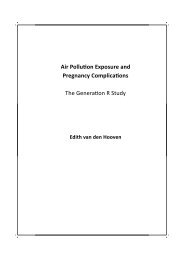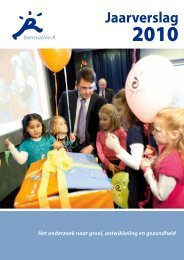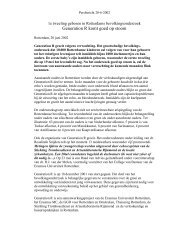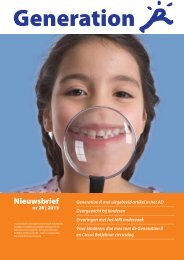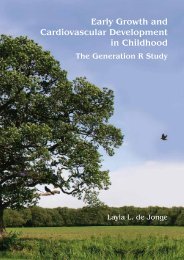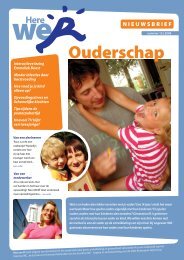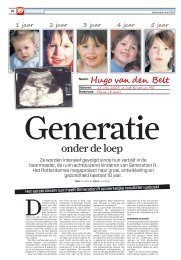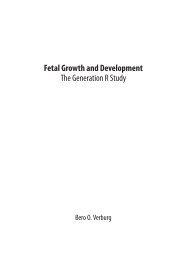Parents and infants: determinants of attachment in a ... - Generation R
Parents and infants: determinants of attachment in a ... - Generation R
Parents and infants: determinants of attachment in a ... - Generation R
Create successful ePaper yourself
Turn your PDF publications into a flip-book with our unique Google optimized e-Paper software.
Chapter 6<br />
Cumulative contextual risk. We constructed a contextual risk composite variable<br />
that has earlier been applied to predict child behavior problems <strong>in</strong> a<br />
large community based study (Belsky & Fearon, 2002). In the current study,<br />
this variable <strong>in</strong>cluded 7 contextual risk factors out <strong>of</strong> 9 that were used <strong>in</strong><br />
the Belsky <strong>and</strong> Fearon (2002) study: ethnic m<strong>in</strong>ority status, low family<br />
<strong>in</strong>come (def<strong>in</strong>ed as below modal monthly family <strong>in</strong>come <strong>in</strong> the Netherl<strong>and</strong>s<br />
i.e. 2000 € after taxes), low maternal educational level (less than 12 years<br />
<strong>of</strong> education), s<strong>in</strong>gle parenthood, low family function<strong>in</strong>g, high maternal<br />
psychopathological symptoms, high parent<strong>in</strong>g stress. Family function<strong>in</strong>g<br />
was assessed with the Family Assessment Device (Epste<strong>in</strong>, Baldw<strong>in</strong> &<br />
Bishop, 1983; Miller, Epste<strong>in</strong>, Bishop & Keitner, 1985) <strong>in</strong> the last trimester<br />
<strong>of</strong> pregnancy. We measured maternal psychopathology at two months postpartum<br />
with the Brief Symptom Inventory, a validated self-report measure<br />
consist<strong>in</strong>g <strong>of</strong> 53 items, which is widely used to assess psychological distress<br />
(De Beurs, 2004; Derogatis, 1993). Parent<strong>in</strong>g stress was measured at 18<br />
months postpartum with the Nederl<strong>and</strong>se Ouderlijke Stress Index – Kort<br />
(NOSIK, De Brock, Vermulst, Gerris, & Abid<strong>in</strong>, 1992), the Dutch version <strong>of</strong><br />
the Parent<strong>in</strong>g Stress Index – Short Form (Abid<strong>in</strong>, 1983). Analogous with the<br />
Belsky & Fearon (2002) approach, we def<strong>in</strong>ed risk status on the last three<br />
variables as the least favorable 20% <strong>of</strong> scores with<strong>in</strong> our sample.<br />
Cumulative risk was def<strong>in</strong>ed as the number <strong>of</strong> risk factors that applied<br />
to every participant divided by the number <strong>of</strong> risk factors endorsed by<br />
the participant to achieve a weighted <strong>in</strong>dex <strong>of</strong> cumulative risk with values<br />
between 0 (none <strong>of</strong> the available factors have risk status) <strong>and</strong> 1 (all available<br />
factors have risk status). For 96% <strong>of</strong> the participants <strong>in</strong>formation on all seven<br />
factors or six out <strong>of</strong> seven risk factors was available. To compare the distribution<br />
<strong>of</strong> cumulative risk with the distribution found by Belsky <strong>and</strong> Fearon<br />
(2002) <strong>in</strong> the NICHD sample, we created four risk groups <strong>in</strong> the same way as<br />
they did (see Table 1): No contextual risk (49.4%), low contextual risk (0.01<br />
- 0.15, equivalent to 1 risk factor, 22%), moderate contextual risk (0.16 - 0.25,<br />
equivalent to 2 risk factors, 8.7%), <strong>and</strong> high contextual risk (> 0.25, equivalent<br />
to 3 or more risk factors, 20% ). These f<strong>in</strong>d<strong>in</strong>gs were very similar to the<br />
f<strong>in</strong>d<strong>in</strong>gs <strong>in</strong> the NICHD sample: 44% no risk, 21% low risk (1 risk factor), 13%<br />
moderate risk (2 risk factors), <strong>and</strong> 22% high risk ( 3 risk factors). For use<br />
<strong>in</strong> the analyses the cumulative risk scores were Z-st<strong>and</strong>ardized <strong>and</strong> outliers<br />
( 3.29) were w<strong>in</strong>sorized to the next highest score (3.08).<br />
114



